Landblog Main
previous archive
Breaking Ground -- 13 May 06 -- A reader mentions a definition of magic by John Updike: "You imagine the future, and then it happens." The more difficult your path, the more you have to invest in imagination. Before I bought land, I'd been thinking about it for 20 years, drawing sketches of how big 40 acres is and what I might put on it, reading books about self-sufficiency, following leads about groups of people buying land. I was thinking even earlier about breaking my dependence on the system, before I could even explain it in words.
But I didn't think much about building a cabin, and I thought even less about building in general. So the cabin is psychologically the most difficult thing I'm trying to do. Last year I dreaded it, and now I've just barely put enough mental energy into it that it's starting to seem a little fun, though still less fun than scary.
On the visit before last, I spent a couple hours just hanging out on the cabin site, thinking about every aspect of it, trying to sit still and get a feeling, and laying out sticks to mark the cabin walls. Two days ago I recalculated directions, rotated the floorplan a bit, and dug it up! I didn't quite finish. The good news is that even in a relatively dry part of my land, there are a lot of roots holding the soil in place. Instead of separating the roots from the topsoil, I just threw it all together in a pile to compost.
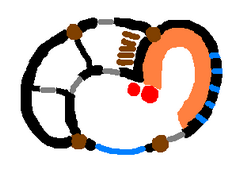 Here's my cabin plan. Someday I might illustrate the whole evolution of this design, from a square, to circles, through some different curvy shapes. The footprint I just cleared, and the first part I'll be building, is the heart-shaped part on the right. The left ventricle is the kitchen and the right ventricle is the sitting area, with a long cob bench in light brown. The red circles are the barrels for the rocket stove, which will feed heat through the bench. The windows are in blue, with glass bottle portholes on the right and a couple big double-paned windows facing south. The doors are in grey, and that's a stack of wood in the one side room. I figure in the winter the front door can be sealed and we can use the back doors with that room as a heat lock. And the dark brown circles are the posts, which will hold up the roof, a single flat slope roughly the size and shape of the edges of the image. The walls will be thicker than I drew them here. And I still need to do more design work on the little rooms to the left. Part of that area will have a basement root cellar. The whole thing is quite small! I figure if I'm working at a counter at the front of the kitchen, I won't even have to move my feet to reach a pot heating on the stove at the back. And I'll need to figure out a loft above the sitting room, to put the bed in.
Here's my cabin plan. Someday I might illustrate the whole evolution of this design, from a square, to circles, through some different curvy shapes. The footprint I just cleared, and the first part I'll be building, is the heart-shaped part on the right. The left ventricle is the kitchen and the right ventricle is the sitting area, with a long cob bench in light brown. The red circles are the barrels for the rocket stove, which will feed heat through the bench. The windows are in blue, with glass bottle portholes on the right and a couple big double-paned windows facing south. The doors are in grey, and that's a stack of wood in the one side room. I figure in the winter the front door can be sealed and we can use the back doors with that room as a heat lock. And the dark brown circles are the posts, which will hold up the roof, a single flat slope roughly the size and shape of the edges of the image. The walls will be thicker than I drew them here. And I still need to do more design work on the little rooms to the left. Part of that area will have a basement root cellar. The whole thing is quite small! I figure if I'm working at a counter at the front of the kitchen, I won't even have to move my feet to reach a pot heating on the stove at the back. And I'll need to figure out a loft above the sitting room, to put the bed in.
This year I'll be very happy if I can get the whole thing excavated, and get the roof framed and covered. All along, the roof has been the hardest part to figure out. I can't find any websites or books in print, other than the 92 year old Shelters Shacks and Shanties, that cover real green roof building. And even that book focuses mostly on the walls. All the natural building books I've seen give just a late chapter to roofs, and most of them tell you to use butyl rubber pond liner, an unsustainable petroleum byproduct, which our ancestors didn't have for a million years and still kept dry. It seems roofs are so difficult that nobody wants to face them head on. Maybe when the pond liner and plywood run out, someone will write a real roof book, with chapters on selecting and shaping logs, on different ways of fitting them together into a structure, on cedar shakes, and thatching, and homemade clay tiles, and experimental surfaces like solid clay in alternating layers that shed and soak up water. One idea I had, which I might try on another structure, is to build a giant cone -- no roof, all wall -- with the whole thing covered with shakes set into cob or nailed to cordwood.
Roof Advice -- 14 May 06 -- Yesterday's post drew a ton of advice. The problem with advice is that everyone has a different set of skills and resources, and most important, different things they enjoy doing. Sometimes I want to say, "That would be a great thing to do, if you came to my land and did it yourself!" But I got a couple suggestions I liked. Aaron writes, "A while back you were talking about building a double roof on your cabin and I think you were on the right track with that." And he mentions how hard it is to keep water from coming through tiny cracks by capillary action, and how some stone age builders made two roofs, an outer one to block the wind and some of the water, and the inner one to stop the water that got through the first.
This was my double roof idea: to build a high post-and-beam roof with a wide overhang, and then not build the walls all the way up! Stop a couple feet short, and build a second roof on top of the walls. It won't have to hold weight, and it will barely have to shed water. It can be mostly just insulation. The whole thing would look like a little cabin under a big four-post umbrella. Another benefit is that I could put the stove outlet on the downhill side of the house, and the air could rise up the underside of the upper roof, instead of having to pipe the air around to the uphill side of the house. (It won't burn the roof because a well-made rocket heating stove is so efficient that the emission is almost smokeless and barely over body temperature.)
Another benefit is that I could go ahead and use pond liner on the upper roof. I wouldn't want to use it on an attached roof because with an airtight membrane you're going to get serious condensation on the underside, and then you have to do all kinds of complicated things to deal with that. But with an unattached roof, the condensation would dry almost as fast as it formed. But the reason I'd want to use pond liner would be to make a living roof... and I don't think I'll do that. It would be more expensive than a cedar shake roof, a lot heavier and therefore harder to engineer, and everything on it is going to turn to toast every summer. Grass on the roof is cool, but not that cool.
So I'm back to cedar shakes on the upper roof. But do I have to use plywood as a base? Todd recommends making the base out of boards scavenged from building sites. If I had a truck, that would be a great way to make back some of the $2500/year continuing expenses of owning it. But I don't, and I'd rather rent a truck and buy lumber than gather 2000 feet of two-by-fours in a borrowed car.
But Sean mentions something I'd been thinking myself, but hadn't found any builders saying: that you don't need a complete base under cedar shakes. Apparently, not only is it acceptable to put boards only where you're going to nail the shakes, it's better! It lets air get to the bottoms of the shakes and prevents mildew. So instead of covering my whole roof with boards, I could just cover a third of it. Or better yet, Sean says instead of boards I could use split three inch logs, something I have in abundance on the land already! So at the moment, that's my plan. If I do it, it's going to take way longer than plywood, and I probably won't finish the roof until next year.
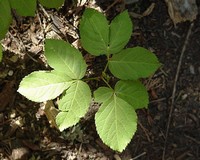 Aralia nudicaulis, Osmia lignaria -- 18 May 06 -- Would you walk bare-legged through this? It's growing all over the moist areas of my land, and at first I thought it was poison ivy. But poison ivy always has three leaves, and this often has two, four, or five. The key is the node where the stem divides perfectly into three parts. That makes it Aralia nudicaulis, Wild Sarsaparilla, a good medicinal plant with a tasty root.
Aralia nudicaulis, Osmia lignaria -- 18 May 06 -- Would you walk bare-legged through this? It's growing all over the moist areas of my land, and at first I thought it was poison ivy. But poison ivy always has three leaves, and this often has two, four, or five. The key is the node where the stem divides perfectly into three parts. That makes it Aralia nudicaulis, Wild Sarsaparilla, a good medicinal plant with a tasty root.
I've also noticed a black bee gathering pollen from oregon grape flowers. I couldn't get a good photo because it's so small and wouldn't stay still, but that link goes to a photo of exactly what it looks like. I'm pretty sure it's Osmia lignaria, the Blue Orchard Mason Bee, friendly and an excellent pollinator. Next time I'll take my hand drill and a 5/16 inch bit, and make a bunch of holes in logs for more of them to live in. I wish human houses were that easy!
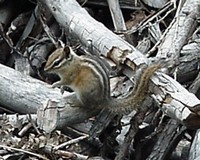 Chipmunk -- 23 May 06 -- Just a quick post to show off this chipmunk photo. Because of the red shoulders and long tail, I think this is a red-tailed chipmunk, Tamias ruficaudus. I just looked around, and this is a better photo than anything I can find on Google, so maybe I'll keep it up. I also saw a smaller grey chipmunk, which I haven't tried to identify. I drilled about 20 bee holes, and watered my seedlings, which are doing the same as last week -- the cherry tree is indeed setting a single fruit in its first season. The wild serviceberry above the cabin is setting a few dozen fruits, and mallow ninebark is blooming on the north hill.
Chipmunk -- 23 May 06 -- Just a quick post to show off this chipmunk photo. Because of the red shoulders and long tail, I think this is a red-tailed chipmunk, Tamias ruficaudus. I just looked around, and this is a better photo than anything I can find on Google, so maybe I'll keep it up. I also saw a smaller grey chipmunk, which I haven't tried to identify. I drilled about 20 bee holes, and watered my seedlings, which are doing the same as last week -- the cherry tree is indeed setting a single fruit in its first season. The wild serviceberry above the cabin is setting a few dozen fruits, and mallow ninebark is blooming on the north hill.
Redesign -- 27 May 06 -- Previously in the landblog cabin saga: I decided a while ago to build 18 inch thick cordwood cob walls. The clay on my land is marginal (it's technically fine silt), and the cob test bricks I made last year are strong enough that I can't break them with my bare hands, but weak enough that I can break them with a hammer. That's good enough for walls but maybe not weight-bearing walls, so I'll do a post and beam roof. When we left off, I was thinking of an elliptical cabin under a rectangular shed roof -- a flat plane tilted at 20-30 degrees, sticking above the cabin like a four-post umbrella. That roof would be cedar shakes on sticks on rafters, and there would be a lighter second roof below it on top of the walls.
Then a reader pointed out that the umbrella roof will blow off in the first big windstorm, unless I do some really difficult stuff to hold it down. Also, I started questioning the whole shed roof idea. They call it a "shed" roof and not a "house" roof for a reason. The less slope it has, the more strong and watertight it has to be to hold up the snow without leaking. But the more slope it has, the more vulnerable the building is on the upslope side. Sloped at 45 degrees, you'd need a ridiculous overhang to protect that side of the building.
I started considering non-flat roofs. How about a cone? The engineering is easy if I cut down the largest dead cedar on the land and make it the center post. Eight beams rest one end on the center post and slope down in all directions to rest on eight more posts. Between the beams go the horizontal pieces of wood that the shakes rest on. Now, how about the inner roof? The inner roof can be grass thatch, and it can go on other horizontal pieces of wood nailed to the bottom sides of the same eight beams. So the thatch will fill up the space made by the thickness of the beams. I think that's pretty clever, and I hope it doesn't turn out to be stupid. I think I can even install the thatch from underneath.
The big advantage of a steep roof with the high spot in the center is I have a good loft. Then I thought of another problem: the loft will be totally dark! Sure, if the tech system goes a few more years I can get LED light bulbs that run off tiny wind turbines. But I want sunlight. So that brings me around to a triangular gable roof like everybody else.
The cabin is elliptical, oriented so the wide part catches the mid-morning sun. The roof rests on three pi-shaped post-beam structures, a high one in the center and short ones on the two sides. The rafters slope down on the beams, and smaller pieces of wood bridge the rafters and hold the shakes on top, and the thatch underneath.
To keep the rafters from sliding down the beams, I'll have to notch them right, but I found some good diagrams of how to do it in Shelters Shacks and Shanties. Another hard part is getting the high beam attached to the posts. I figure I can assemble the whole thing on the ground and then find a way to pull it upright and drop the posts into the holes. And the loft can simply rest on the two lower beams. It's still a ton of work, and will probably take me three summers.
Mallet and Chisel -- 8 June 06 -- I'm a sucker for really good tools. After doing a bunch of research, I just bought a Barr framing chisel and a 20 ounce Wood is Good mallet. I found better prices than on those links, but still, after shipping, $160 for something to shape wood and something to hit it with. What I'll use them for is making the joints that fit the logs together in my roof. And in 20 years, when I have some bigger douglas fir trees that need to be thinned, I can make a full timber-framed cabin.
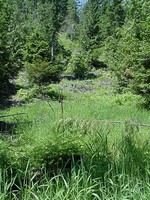 Green -- 12 June 06 -- The first half of spring was dry, and the second half has been wet. I've never seen the land this green. Here's a new photo of the west hill, and this year I didn't amp up the color saturation. That grass in the bottom half is reed canary grass, which grows more than six feet tall and should be good for thatching and cob. I took this Friday, when Chris and I went up to the land to water the seedlings and do some more digging in the cabin footprint.
Green -- 12 June 06 -- The first half of spring was dry, and the second half has been wet. I've never seen the land this green. Here's a new photo of the west hill, and this year I didn't amp up the color saturation. That grass in the bottom half is reed canary grass, which grows more than six feet tall and should be good for thatching and cob. I took this Friday, when Chris and I went up to the land to water the seedlings and do some more digging in the cabin footprint.
 At the top of the north hill, we saw this, a baby deer lying still in the grass. It wasn't hurt -- this is a survival strategy. Deer are born with no scent, and most of their predators have no color vision. So instead of running, the deer collective consciousness figured out that it's better to hide. 21st century science will explain this in terms of "morphic resonance," and I believe there are still some primitive 19th century scientists who explain it in terms of DNA.
At the top of the north hill, we saw this, a baby deer lying still in the grass. It wasn't hurt -- this is a survival strategy. Deer are born with no scent, and most of their predators have no color vision. So instead of running, the deer collective consciousness figured out that it's better to hide. 21st century science will explain this in terms of "morphic resonance," and I believe there are still some primitive 19th century scientists who explain it in terms of DNA.
Another example of the intelligence outside humans: A few weeks ago, when I saw that blue orchard bee, it was actually trying to be seen! It would fly away and then come back to a flower right next to me. It did that two visits in a row. Then after I identified it and figured out that I should drill 5/16 inch holes in stumps to attract more, I stopped seeing them.
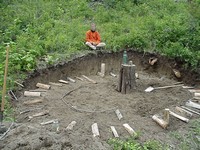 Different Flows -- 18 June 06 -- Here's a photo of the completed cabin footprint and Chris, who did most of the digging. The wood around the edges represents the 18 inch thick walls, the stump is the rocket stove barrel, the little sticks are the kitchen counter, and you can barely see the piled dirt representing the cob bench. Chris did most of the digging because he got in a groove and I didn't want to tell him to slow down. But now I understand better why I don't want to use power tools. Even with a second human, I felt the speed of the project threatening the care and precision that I wanted.
Different Flows -- 18 June 06 -- Here's a photo of the completed cabin footprint and Chris, who did most of the digging. The wood around the edges represents the 18 inch thick walls, the stump is the rocket stove barrel, the little sticks are the kitchen counter, and you can barely see the piled dirt representing the cob bench. Chris did most of the digging because he got in a groove and I didn't want to tell him to slow down. But now I understand better why I don't want to use power tools. Even with a second human, I felt the speed of the project threatening the care and precision that I wanted.
Everybody gets in a groove, or "the flow," when they're doing work they enjoy. But I've just now figured out that different people get in different flows, or channel different spirits. Maybe it also depends on what they're doing. Some people get in a speed flow, where they have to keep going fast or they crash. This expains how certain writers can crank out one 600 page book after another. I get in a precision flow. When I'm writing, a paragraph might take me a minute or an hour -- what keeps me going is not my pace, but keeping my attention on every detail, and if I lose that, I crash.
I wonder if any business management books talk about this. From now on, when I have helpers on my land, I'm going to figure out what flows they get in, and try to match them with the kind of work that fits it.
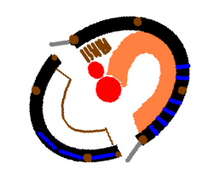 Designer/Builder -- 18 June 06 -- And here's the new cabin design. That's the cob bench on the right and the kitchen counter on the left. I'm getting better at using MS Paint, but notice how much less cool this floorplan is than the one I drew five weeks ago. If I had power over others, I could just command that one to be built. But because I'm also the builder, I can overrule myself as designer, and say, "Sure it's pretty, but this other design is only slightly less functional and much easier."
Designer/Builder -- 18 June 06 -- And here's the new cabin design. That's the cob bench on the right and the kitchen counter on the left. I'm getting better at using MS Paint, but notice how much less cool this floorplan is than the one I drew five weeks ago. If I had power over others, I could just command that one to be built. But because I'm also the builder, I can overrule myself as designer, and say, "Sure it's pretty, but this other design is only slightly less functional and much easier."
Empires collapse because designers rule builders -- not just in housebuilding but in everything. Consider the Iraq occupation. The Neocons sit in air-conditioned rooms in Washington making beautiful dreams of a corporate socialist utopia rising from the desert. The actual soldiers get there and see that the plan is stupid, but the builders are not permitted to correct the designers. Empires collapse because the people who look at maps are the bosses of the people who look at the territory, and the maps decay into fantasy.
I'm tempted to say I'm against beauty, but I do want to build a beautiful cabin. The word has opposite definitions: Empire culture thinks of beauty as something created by pure imagination and then imposed on dead physical matter. I think of beauty as something that arises from the aliveness in everything, working together. Good painters don't just transfer imagination to canvas -- they accept feedback from the physical reality of the canvas and the paint, and create something they could not have imagined. I intend to do the same thing with rocks and wood and dirt.
Roof Redesign -- 27 June 06 -- The last design went like this: six posts, holding three beams, holding about eight rafters, holding around 50 slats, holding several hundred cedar shakes, and then another layer of slats on the bottoms of the rafters holding a layer of thatch. But now that I'm getting closer to the actual work, seven layers of material is intolerable. I have to strip it down.
Instead of rafters and slats, could I just put roofing straight on the beams? I can't split 12 foot cedar shakes, but I can buy 12 foot planks. I checked some notes I took at Home Depot and figured I can do the whole roof for under $500. The problem is, between each of the planks is a crack through which water will leak, unless I do a whole second layer of planks -- which still might leak. Also, I still have to do something like rafters to hold whatever insulation goes under the wood.
From there, I thought about doing a lot of posts and beams, so the beams are close enough together to serve as slats without the intermediate rafters. But that gets in the way of windows and doors, and I still need insulation... and now that I'm imagining a frame of close-together horizontal pieces, it's an easy jump to the new plan: all thatch!
Here's a good page on thatching. The advantages are: 1) The materials are free on my land. 2) When done right, it really does keep the weather out, even deep snow. Here's a page about Nozawa, a village in Japan that gets ten feet of snow a year and has thatched roof inns. 3) It's a great insulator. 4) It's light enough that the walls will bear it -- I don't need a post and beam structure at all!
The disadvantages are: 1) The material on my land, reed canary grass, is not normally used for thatching, and is probably not ideal. But it's a common "invasive" grass of wetlands, and we need to learn to use it because there's going to be a lot of it around. 2) Doing thatching right is very difficult. Before industrial roofing, people spent lifetimes learning to thatch. Compared to them, I'm going to do a sloppy job, and the roof might leak for a few years until I get better at it.
The implications on my plans are: 1) The roof needs to be steeper now, at least 45 degrees. That means the loft will be higher and narrower. I'll probably be able to stand up in it. 2) Oddly, the first thing I need to build is the loft. Next year it will be what we stand on when we're building the high walls and roof, and this winter I can drape a tarp over it and use it to shelter the grass harvest. I figure six modest posts, and three beams exactly four feet apart for a pallet wood ceiling/floor. 3) Assuming I get the loft/shelter finished, I'll spend half of October harvesting grass.